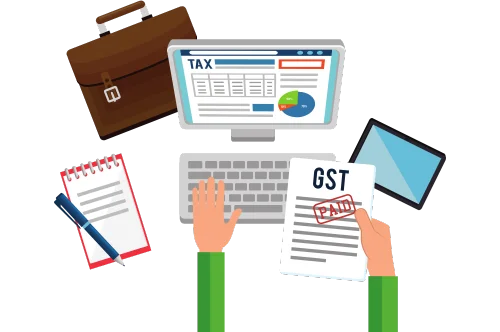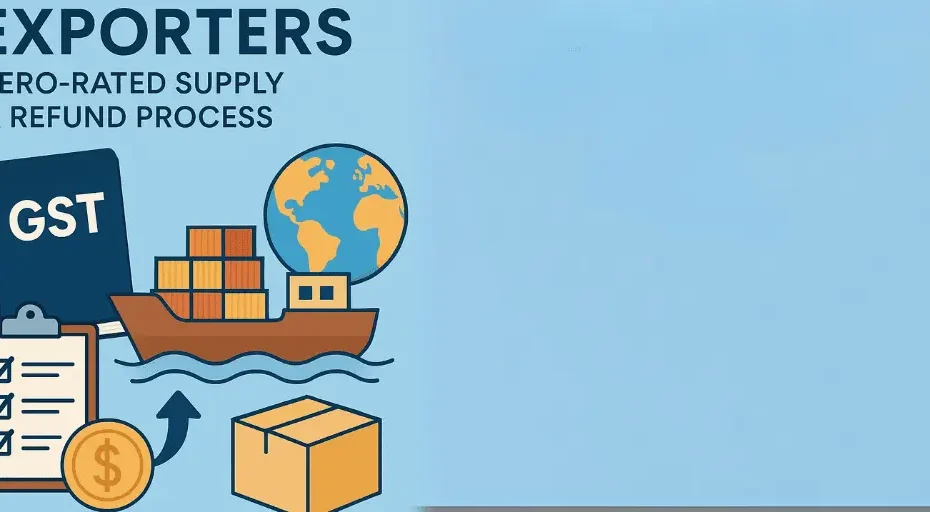GST for Exporters: Zero-Rated Supply & Refund Process
When it comes to boosting the competitiveness of Indian businesses on the global stage, the GST for exporters plays a crucial role. The Goods and Services Tax (GST) regime offers several benefits for exporters, mainly through the concepts of zero-rated supply and refund processes. Understanding these mechanisms is essential for every business aiming to succeed internationally while maintaining strong liquidity at home.
In this blog, we’ll dive deep into how GST for exporters works, what zero-rated supply means, and how the refund process is structured under the GST framework.
Understanding GST for Exporters
The Indian government has always encouraged exports to promote economic growth and earn foreign exchange. To support this goal, the GST framework has made special provisions specifically tailored for exporters. Under gst for exporters, the supply of goods or services for export is treated as a zero-rated supply.
This means that even though the general principle of GST is that it should apply to the supply of all goods and services, exports are exempted. Exporters either don’t have to pay GST at all or can claim a full refund of the GST paid on inputs. Thus, gst for exporters ensures that Indian products and services remain competitive in the international market.
What is Zero-Rated Supply?
Zero-rated supply is a core concept under gst for exporters. In simple terms, it means the goods or services exported from India are taxed at a GST rate of 0%. However, even though no tax is charged on the final exported goods, exporters are allowed to claim input tax credits for the GST paid on their purchases and expenses.
Under gst for exporters, zero-rated supplies include:
Export of goods
Export of services
Supplies made to Special Economic Zones (SEZ) developers or units
This provision ensures that exporters are not burdened by any GST and can stay competitive by recovering the taxes paid during production and supply.
How Exporters Can Make Use of GST Provisions
There are two main ways in which exporters can manage their GST obligations:
Export under Bond or LUT (Letter of Undertaking) without Payment of IGST
Exporters can export goods or services without paying Integrated GST (IGST) by furnishing a Bond or LUT. Later, they can claim a refund of the input tax credit accumulated on their purchases.Export with Payment of IGST and Claim Refund
Alternatively, exporters may choose to pay IGST at the time of export and subsequently claim a refund of the same.
In either case, gst for exporters ensures that the burden of GST does not rest with the exporter and that taxes paid earlier in the supply chain are refunded in full.
The GST Refund Process for Exporters
Understanding the refund process is crucial because cash flow is essential for any business, especially those involved in exports. Under gst for exporters, here’s how the refund process works:
1. Filing the Refund Application
Exporters must file an application in Form GST RFD-01 electronically through the GST portal. The application must be accompanied by the necessary supporting documents, including shipping bills, export invoices, and bank realization certificates (BRCs) in the case of services.
2. Verification by Authorities
The GST authorities will verify the documents submitted. If everything is in order, the refund claim is processed promptly. In most cases, the law mandates that refunds should be issued within 60 days from the date of application.
3. Provisional Refund
To ease liquidity issues, 90% of the refund amount can be granted on a provisional basis within seven days of filing the refund application, especially for exporters with a clean record.
4. Receiving the Refund
Once the verification is complete, and any issues are resolved, the refund amount is credited directly to the exporter’s bank account.
The entire process under gst for exporters has been simplified to minimize delays and ensure the working capital needs of exporters are adequately met.
Key Documents Required for GST Refund
For smooth processing of GST refunds under gst for exporters, it is important to keep the following documents ready:
Export invoices
Shipping bills or bill of export
Bank Realization Certificates (BRC) or Foreign Inward Remittance Certificates (FIRC) for service exporters
LUT/Bond details (if applicable)
GST returns (GSTR-1 and GSTR-3B)
Maintaining accurate and timely records ensures there are no hurdles in the refund process.
Common Challenges Faced by Exporters
Despite the clear procedures under gst for exporters, businesses sometimes face challenges such as:
Delay in receiving refunds
Errors in GST return filing (GSTR-1 mismatches with GSTR-3B)
Technical glitches on the GST portal
Complicated documentation requirements
However, with proper planning, regular reconciliations, and professional advice, these challenges can be effectively managed.
Recent Updates in GST for Exporters
The government continuously works to simplify the process and encourage exports. Recent initiatives include:
Introduction of automatic refunds for eligible exporters
Simplification of refund application processes
Reduction in the requirement of supporting documents
Greater use of technology and data analytics to speed up verification
These measures highlight the growing importance of gst for exporters and the government’s commitment to facilitating seamless export operations.
Benefits of GST for Exporters
There are multiple benefits of gst for exporters, such as:
Enhanced liquidity through quick refunds
Competitiveness in the global market due to zero tax burden
Transparent and technology-driven processes
Reduction in tax cascading
Greater predictability and ease of doing business
In short, gst for exporters provides a powerful incentive for Indian businesses to expand their international reach.
Conclusion
In today’s global economy, understanding the provisions of gst for exporters is not just beneficial but necessary for any Indian business aiming for global expansion. The zero-rated supply and refund mechanisms ensure that exports remain tax-free and that working capital is not unnecessarily blocked.
Whether you are a small enterprise taking your first steps into international trade or a large corporation expanding your global footprint, the gst for exporters regime offers significant financial and operational advantages. By leveraging the benefits effectively and staying compliant, exporters can achieve sustainable growth and compete confidently in the international market.
Our GST Services

All E-commerce Tax services
E-commerce tax services help online sellers navigate GST registration, compliance, return filing, TCS management, tax planning, and audits, ensuring efficient tax management and legal compliance.

GST Filing
GST filing is the process of submitting tax returns to the government, detailing sales, purchases, and taxes paid or collected, ensuring compliance with GST laws.

GST Registration
GST registration is the process where businesses obtain a GSTIN from the government, allowing them to collect taxes, claim input tax credits, and comply with GST laws.





